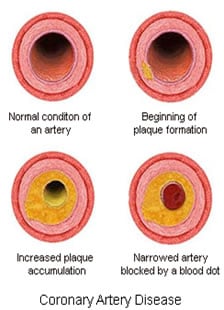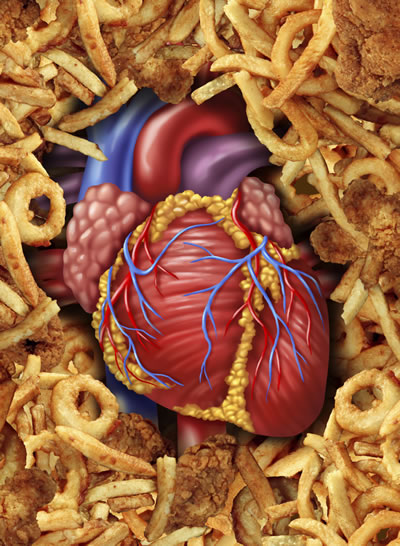How To Prevent a Second Heart Attack
Act now. It could save your life. According to the American Heart Association, one of four men and one of three women who survive a heart attack will die within the following year, most often of cardiac arrest or another heart attack. Consider an intensive cardiac rehabilitation program, like the one at the Pritikin Longevity Center. It will teach you, under the careful supervision of board-certified physicians, how to eat well, exercise well, and live well, and in doing so, help prevent a second heart attack.

How To Prevent a Second Heart Attack
To understand how to prevent a second heart attack, it’s important to understand why the first heart attack likely occurred, and what heart disease is.
It’s also important to understand that you’re not alone.
Heart disease is the #1 killer in the U.S. of both men and women. The Centers for Disease Control has estimated that someone in America is having a heart attack every 34 seconds. Every 60 seconds someone is dying from a heart disease-related event.
How To Prevent a Heart Attack
9 Steps For Improving Heart Health Naturally
Pritikin Intensive Cardiac Rehab (ICR)
What Is Heart Disease?
Most heart disease results from an inflammatory process within the arteries called atherosclerosis. Atherosclerosis injures and clogs arteries, and it can develop in any artery of the body.

Plaque
The material inside the arteries causing the blockage is commonly referred to as plaque. Plaque causes the inner walls of the arteries to balloon and swell to accommodate the space that plaque occupies. The process becomes critical when small blood clots form near the plaque, which can completely choke blood flow to vital organs.
In most cases, it is the sudden rupture of the weakened area (plaque) that triggers blood clots and stops blood flow, causing an interruption in the supply of nutrients and oxygen to the involved organ (heart, brain, etc.). Depending upon which cells and tissues die, the result could be a heart attack, stroke, or other circulatory problem.
Heart Disease Risk Factors
Plaque builds up in the walls of the arteries for many reasons. Here are four key risk factors:
- High forms of bad cholesterol, such as LDL and non-HDL
The higher the bad cholesterol concentration in your blood, the more plaque you are likely to have, and the more damaged your artery walls become. - High glucose (blood sugar)
- Hypertension (high blood pressure)
- Smoking
How To Prevent a Second Heart Attack
Decreasing heart attack risk depends largely on your lifestyle. Healthy changes in the way you live, particularly diet and exercise, have been proven to:
- Dramatically reduce heart disease risk factors like high LDL and non-HDL cholesterol, high glucose, and hypertension
- Stabilize plaques
- Slow down, and even reverse the progression of coronary heart disease.
Diet – The Most Significant Lifestyle-Related Factor

A large body of research (detailed later in this article) has found that the following dietary characteristics, all part of the Pritikin Eating Plan, are effective in reducing bad cholesterol and other risk factors, and reverses the progression of heart disease:
-
Reduce saturated fats, trans fats, and cholesterol in the diet.
Foods rich in saturated fats include red meats, processed meats like bacon and bologna, coconut oil, palm kernel oil, and fatty dairy foods like cheese, ice cream, butter, and whole milk.
Foods high in trans fats are often margarines, fries, donuts, cookies, crackers, and other snack foods. Avoid foods containing partially hydrogenated oil – i.e., trans fat.
Foods especially high in dietary cholesterol are egg yolks and organ meats.
-
Increase fiber in the form of whole, nutrient-rich foods like fruits, vegetables, whole grains, and beans.
Other Key Lifestyle-Related Measures To Prevent Heart Attacks Include:
- Smoking cessation
- Blood pressure control
- Physical activity
- Weight management, particularly reductions in abdominal (belly) fat
- Blood sugar control
- Stress management
Medical Care
How To Prevent a Second Heart Attack
No matter how healthy your lifestyle, it’s vital to consult regularly with your cardiologist to give your heart optimal protection. Physician-supervised care, states the National, Heart, and Blood Institute, should involve not only lifestyle-change education but also:
- Medicines, if needed, to control chest pain or discomfort, high blood cholesterol, high blood pressure, and your heart’s workload
- A cardiac rehabilitation program
A Medicare-approved form of cardiac rehabilitation, called intensive cardiac rehabilitation (ICR), is conducted at the Pritikin Longevity Center.
Like traditional cardiac rehab (CR) programs, Pritikin’s ICR program focuses on exercise. But it also provides comprehensive education in all the key skills that foster a healthy lifestyle, including food shopping, cooking, dining out, smoking cessation, and reducing the stress in your life.
What Science Says
How To Prevent a Second Heart Attack
Below is a summary of key research over the last three decades on the benefits of lifestyle interventions for the heart:
- Sixty-four patients with coronary artery disease were recommended by their cardiologists to have bypass surgery. Instead, they chose to attend the Pritikin Longevity Center. In the follow-up study conducted five years after the patients had left Pritikin, researchers at UCLA reported that 80% of the patients had never needed bypass surgery. In addition, 68% of those who had suffered from angina (chest pain) before coming to Pritikin reported being completely free of angina.1
- Scientists at University of Southern California showed that a combination of drugs and diet decreased plaque lesions in the arteries of humans.2
- Researchers at University of California, San Francisco, showed that lifestyle changes – a low-fat, fiber-rich diet, regular exercise, and stress management – caused shrinking of plaque in most people with atherosclerosis, and without the need for any heart or cholesterol-reducing medications.3
- The Stanford Coronary Risk Intervention Project followed 300 people with coronary artery disease for four years. Half were assigned to usual care (no lifestyle intervention), and half received intensive lifestyle education in dietary change, exercise, smoking cessation, and stress management. The best predictor of new coronary blockages was dietary fat intake. As fat intake rose, the number of coronary blockages rose. Those patients with the lowest intake of dietary fat (about 10% to 15%, like the Pritikin Eating Plan) had the greatest amount of plaque shrinkage, or regression.4
- Caldwell B. Esselstyn, Jr., MD, at the Cleveland Clinic Foundation found that a plant-based diet in conjunction with cholesterol-reducing medication reversed heart disease in 70% of patients over a 12-year period. All patients who maintained the diet achieved the total cholesterol goal of less than 150 and had no heart attacks or other heart-related problems during the 12 years. These data are particularly compelling considering that the same group had experienced more than 49 coronary events during the eight years before the study.5
- Scientists at the University of Washington conducted a study involving 202 people with a history of heart attacks. Half were given intensive dietary education (similar to the education received at the Pritikin Longevity Center). The remaining 101 patients received minimal education (one short visit from a dietitian). Six years later, the intensive education group had slashed the risk of cardiovascular events, including heart attacks and deaths, by two-thirds compared to the minimal care group.6
- Among 333 coronary artery disease patients, all of whom had been recommended for angioplasties or coronary bypass surgery, 194 elected to forgo the procedures and instead adopt lifestyle changes similar to the Pritikin Program. After three years, 77% in the lifestyle-change group had still avoided the surgeries.7
- Research funded by the U.S. Army followed 158 coronary patients with activity-limiting angina and 90 with mild angina. After three months of lifestyle intervention that included a predominately whole foods diet low in fat (10% of calories) and moderate exercise, 186 of the patients were angina-free and 23 reduced their angina from activity-limiting to mild.8
- Summed up Dr. Esselstyn in Preventive Cardiology: “Compelling data from nutritional studies, population surveys, and interventional studies support the effectiveness of a plant-based diet and aggressive lipid [cholesterol]-lowering to arrest, prevent, and selectively reverse heart disease. In essence, this is an offensive strategy.”9 A diet like the Pritikin Eating Plan, based on fiber-rich plant foods, “can achieve total disease arrest and selective regression even in advanced cases,” concluded Dr. Esselstyn.
Why Heart Patients Do Well With Lifestyle Interventions Like the Pritikin Program
Research, as outlined above, demonstrates reversal (regression) of plaque build-up, but scientists are finding that many other biological benefits are also taking place. Here are three:
1. Improvement in the arteries’ ability to dilate, or open up
Using PET scans, scientists at UCLA measured blood flow in people before and after they began the Pritikin Program. The “after” scans showed an increase in the ability of the coronary circulation to vasodilate (open up) and increases in maximum coronary blood flow.10
Similar results11 have been reported for other patients following a very-low-fat diet and exercise intervention.
Metaphorically speaking, when your arterial “highways” are wide open, your blood cells have little problem delivering more oxygen to the heart.
Studies have also shown that one single high-fat meal has just the opposite effect on the arteries, namely, it causes constriction (vasoconstriction) and reduces maximum blood flow, like traffic that has slowed to nearly a standstill.12
2. Reduced inflammation
Inflammation can be a very good thing. Think of inflammation like a burner on a gas stove. When you suffer an injury, like a cut on your finger, your body turns up the flame. Your immune system sends in an army of white blood cells that fight infection and promote healing. This is called local or acute inflammation.
But problems can occur for the arteries and heart when your body keeps that burner going.
This low, steady burn, known as chronic inflammation, is not caused by a single injury. Rather, it’s the result of constant injury to the inner walls of our arteries, and it’s brought on by excess LDL (bad) cholesterol and other lifestyle-related insults like high blood pressure, high blood glucose, and smoking.
Chronic inflammation leads to the formation of fatty streaks throughout our arteries, which can eventually lead to cholesterol-rich plaques.
Heart attack prevention is all about quelling these inflammatory flames. In several studies, the Pritikin Program has been proven to lower inflammatory markers, including high-sensitivity C-reactive protein, in men,13 women,14 and children.15
Other markers of inflammation include noxious chemicals released by both white blood cells and fat cells. They’re called inflammatory cytokines. In recent research on overweight and normal-weight children at the Pritikin Longevity Center, scientists found that within two weeks, levels of inflammatory cytokines dropped markedly.16
Similar results, published in studies over the past decade, have been observed in adults attending the Pritikin Program.
3. Reduction in risk of plaque rupture and blood clots
Plaque rupture occurs in what are known as vulnerable plaques – cholesterol-rich plaques with a high level of inflammation. The inflammation is thought to activate enzymes like matrix metallo proteinases.
These enzymes do a lot of dirty work. Like sandpaper rubbing on an inflamed boil, they degrade the fibrous cap covering the cholesterol plaque, making the cap vulnerable to cracking or rupture.
The Pritikin Program has been shown to reduce the level of one of the metalloproteinases (MMP-9),17 which should immediately reduce the risk for plaque rupture, blood clot formation, and a heart attack.
If plaque does rupture, the plaque’s contents spew out into the bloodstream, triggering a swift gathering, or aggregation, of blood platelets. Plateletes are cells that circulate in the blood and clot to heal injuries. But clotting that occurs within our arterial pipelines can build to the point where it blocks blood flow. Research on Pritikin Program participants has shown a reduction in the tendency for platelets to aggregate and clots to form.18
Summing Up…
How To Prevent a Second Heart Attack
Act now. It could save your life. According to the American Heart Association, one of four men and one of three women who survive a heart attack will die within the following year, most often of cardiac arrest or another heart attack.
Consider an intensive cardiac rehabilitation program, like the one at the Pritikin Longevity Center. It will teach you, under the careful supervision of board-certified physicians, how to eat well, exercise well, and live well, and in doing so, help prevent a second heart attack.
What’s more, there’s a good chance you’ll actually have fun doing it. Many people have described Pritikin as America’s cardiac rehab spa.
Most importantly, a Pritikin retreat is your best shot at getting back the life you love, and quite possibly, an even better one, rich in energy and good health.
Sources
- 1 Journal of Cardiac Rehabilitation, 1983; 3: 183.
- 2 JAMA, 1990; 263 (12): 1646.
- 3 JAMA, 1998; 280: 2001.
- 4 Circulation, 1994; 89 (3): 975.
- 5 American Journal of Cardiology, 1999; 84: 339.
- 6 American Journal of Cardiology, 2008; Jun 1;101(11): 1523.
- 7 American Journal of Cardiology, 1998; 82 (10B): 72T.
- 8 American Journal of Cardiology, 2008; 101 (7): 911.
- 9 Preventive Cardiology, 2001; 4: 171.
- 10 Circulation, 1995; 92: 197.
- 11 Journal of the American College of Cardiology, 2003; 41: 263.
- 12 Journal of the American College of Cardiology, 2000; 36: 1455.
- 13 Journal of Applied Physiology, 2006; 100: 1657.
- 14 Metabolism, 2004; 53: 377.
- 15 Atherosclerosis, 2007; 191: 98.
- 16 American Journal of Physiology: Regulatory, Integrative, and Comparative Physiology, 2013; 305: R552.
- 17 Journal of Applied Physiology, 2006; 100: 1657.
- 18 Prostaglandins, Leukotrienes and Medicine, 1987; 26: 241.